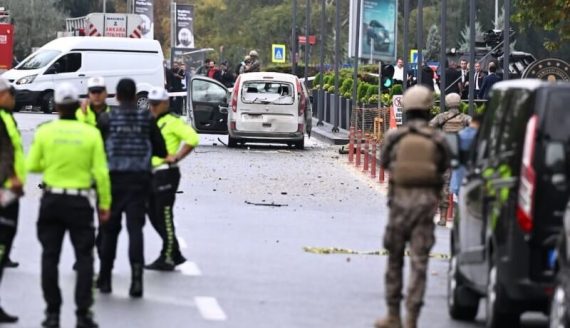O
n the morning of Sunday, October 1, around 9.30 a.m., during the opening day of the new legislative session of the Turkish Grand National Assembly (TBMM), two PKK terrorists arrived in a light commercial vehicle at the entrance to the complex housing the Turkish Ministry of Interior and the General Directorate of Security. Using long-barreled firearms, they carried out a suicide attack.
In the aftermath of the incident, an initial official statement by the Turkish Minister of Interior Ali Yerlikaya revealed that one of the terrorists detonated an explosive device, while the other assailant was effectively neutralized by law enforcement personnel.
The Ankara terrorist attack, due to its timing, target, the affiliation of the perpetrators, and the modus operandi requires a careful and thorough examination.
Examining the unusual aspects of the attack
At the outset, it is imperative to acknowledge the limited open access information on the planning, reconnaissance, and financing phases of the attack. Nevertheless, a comprehensive examination of the operational methodology is possible by examining CCTV footage.
The available footage shows that at approximately 9:30 a.m. local time, a grey Renault Kangoo vehicle arrived at the prescribed coordinates. Two terrorists, armed with long-barreled firearms and a rocket-propelled grenade launcher, alighted from the vehicle and proceeded to directly target the guards stationed at the compound’s checkpoint gate.
The attack took the form of an abrupt incursion, with one of the assailants attempting to breach the checkpoint’s ballistic fortifications with the rocket launcher. At the same time, the other assailant activated an explosive device in order to facilitate the entry of the second terrorist into the area, while rendering the checkpoint security personnel ineffective.
Intelligence reports indicate that an armed confrontation ensued between the first assailant, who was trying to breach the checkpoint, and the law enforcement personnel. The prompt intervention of the security forces resulted in the neutralization of both assailants, although two police officers, Alim Reis Demirel and Erkan Karataş, were slightly injured.
While the manner in which the Ankara terrorist attack was carried out, i.e., a sudden and violent breach of a checkpoint, has tactical parallels with an earlier incident in Mersin, it is important to highlight the notable technical differences between the latest incident and the Mersin episode, including facets such as the typology of targets, the specifications of equipment, and the profiles of the perpetrators.
It is worth recalling that in the bombings of the Güvenpark bus stops and the nearby police station in Ankara, a white BMW 5.20 had been purchased from a shop in Şanlıurfa some 25 days before the attacks. In a parallel development, the car bombing in Merasim Sokak in Ankara, which coincided with the transit of military convoys, involved the use of a Volkswagen Scirocco. This vehicle had been rented from Izmir some 15 days before the attack and had not been returned at the end of the rental period, leading to reports of its theft.
Both vehicles used in the above attacks, had been previously documented on CCTV cameras in the vicinity and reconnaissance activities had been scheduled at least five days prior to the attacks. Nevertheless, the most recent attack stands out due to the fact that it was stollen, and the conspicuous absence of an extended reconnaissance phase involving the vehicle. Furthermore, the geographical proximity of the region where the vehicle was hijacked to the provincial border of Adana, provides important insights into the presumed trajectory of the terrorists on their way to Ankara.
According to initial information gathered after the attack, the Renault Kangoo used in the offensive was officially registered to the veterinarian Mikail Bozloğan, a resident of Kayseri province. Subsequent investigations revealed that the vehicle had been commandeered following a deadly assault on Bozloğan, which resulted in a gunshot wound to the head, and a subsequent robbery. The incident took place in in the Avlağa neighborhood of Çataloluk village, close to Adana.
Weapons cache and connections
In the aftermath of the attempted attack, following an investigation launched by the security forces, a cache of weapons was seized, consisting of 9,700 kg of C-4 explosives, three hand grenades, a rocket launcher (specifically the RPO-A Shmel thermobaric rocket launcher), a Glock pistol fitted with a suppressor, a Blow pistol, a M4 carbine with an extended barrel, and a AK-47 with an extended barrel.
Of particular importance is the M4 carbine, a weapon developed by the American company Colt. Celebrated for its rapid-fire capabilities and lightweight design, the M4 is primarily used in close-quarters combat, with an effective range of 350 meters, and is among the weapons sent by the United States to the PKK/YPG.
The most conspicuous among the seized weapons systems is the RPO-A Shmel with a range of 20 to 1,000 m. This weapon was used by the assailant who attempted to breach the ballistic defenses at the checkpoint gate. The RPO-A Shmel, similar to the Light Anti-Tank Weapon (LAW) developed by the Soviets, is characterized by its thermobaric composition, which gives it incendiary properties, and had been previously seized by the Turkish Armed Forces (TSK) during operations in Syria in 2022 and 2020.
Furthermore, the RPO-A Shmel was used in an attack by PKK terrorists in the Metina region in 2020, which resulted in the death of five Peshmerga fighters. It is known that operatives in terrorist organizations are subjected to specialized training regimes to achieve proficiency in the operation of this weapon system. Meanwhile, the protracted Syrian civil war has, to some extent, facilitated the acquisition of such weapons by terrorist organizations.
Terrorist faction and motivation
The attack, which took place on the opening day of the Turkish Grand National Assembly, was claimed by a faction of the People’s Defense Forces (HPG), the military wing of the Kurdistan Workers’ Party (PKK), known as the “Immortal Battalion.” The terrorist organization named the perpetrators as operatives under the aliases “Rojhat Zihan” and “Erdal Şahin.”
Following forensic investigations, the government authorities have officially confirmed that one of the neutralized terrorist was Hasan Oğuz. The identity of the other assailant is currently the subject of ongoing forensic investigation. As the results of these investigations crystallize, they will serve to clarify the context of the attack.
Given that the “Immortals’ Battalion” operates under the direct authority of the terrorist organization’s top leadership, specifically under the command of Murat Karayılan, it is reasonable to assume that the order for the attack came from the highest levels of the organization’s hierarchy.
The communiqué issued by the terrorist organization claiming responsibility for the attack, stated that the attack was dedicated to the memory of deceased terrorist Hülya Demirer, known by the alias “Axin Muş.” Demirer is said to have been a member of the HPG and YJA Star Command Council and, in particular, served as the “Amed” province commander within the organization’s hierarchy. The attack was explicitly dedicated to her associates, specifically “Rohat Pasur” (Cihat Ay), “Egid Berxwedan” (Habib Karakoç), and “Demhat Setkar” (Çetin Temel). These terrorists had been neutralized in an operation carried out in Diyarbakır’s Kulp district in September 2022.
The operation had been carried out under the auspices of the Intelligence Directorate of the General Directorate of Security, and involved the use of the latest technology, including UAVs of the General Directorate of Security and UCAV platforms of the Gendarmerie General Command. The neutralized terrorists had been prominently featured on the Ministry of Interior’s list of wanted terrorists, color-coded “red,” “orange,” and “grey” respectively.
Importantly, Hülya Demirer is known to have played a key role in orchestrating a series of bomb attacks: the attack in Istanbul’s Sancaktepe district on May 12, 2016; in Istanbul’s Fatih-Vezneciler district on June 7, 2016; in Istanbul’s Beşiktaş district on December 10, 2016; and, most recently, along the Diyarbakır-Mardin highway on December 16, 2022.
From the point of view of the terrorist organization, the decisive neutralization of such a consequential figure represented a profound development, especially in terms of eroding the morale and motivation of its domestic human resources in Turkey. The attack of October 1 served the dual purpose of sending a message to the organization’s dispirited human resources in Turkey, and confirming the organization’s continued ability to carry out attacks on strategic targets within Turkish territory.
Recommended
Government response and navigation of complex threats
In the wake of the attack, Interior Minister Yerlikaya emphasized that, as part of the fight against terrorism and organized crime, the ministry would continue to target individuals and groups involved in supporting terrorism, drug trafficking, criminal syndicates, and organized crime. The ministry’s recent efforts have culminated in remarkable operations that resulted in the arrest of 90 drug traffickers and the pre-emptive detention of 41 members of the prominent “Şahinler Gang” just before the aforementioned attack.
Drug trafficking remains a key source of funding for terrorist activities. Turkey has continued its fight against terrorism for several years with a multifaceted approach that includes law enforcement and military strategies. The measures taken to curb the financing of such attacks have recently evolved into a systematic counterterrorism strategy.
In response to the attack, the TSK acted swiftly, carrying out aerial operations against 20 designated targets in the northern regions of Iraq, including Metina, Hakurk, Kandil, and Gara. Turkey’s military presence in northern Syria and Iraq exerts significant pressure on terrorist organizations and acting in a coordinated manner, Turkey is vigorously engaged in the fight against terrorism, involving not only its military components but also its intelligence and law enforcement agencies.
The unfolding situation in Ankara remains fluid, and while certain details remain unclear, the attack has underscored the ever-challenging task of maintaining security and countering a range of threats. Inter-agency coordination will emerge as an indispensable facet of the effort to unravel the full dimensions of the attack and to determine culpability.





